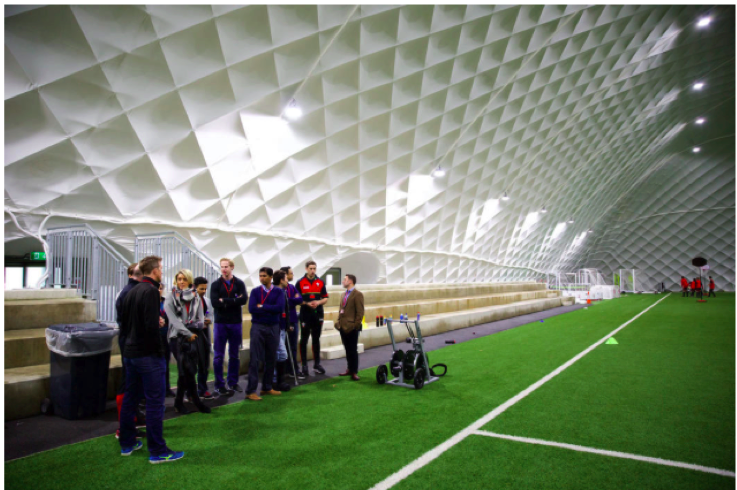Sport and Exercise Medicine: The UK trainee perspective –A BJSM blog series
By Ralph Smith and James Baldock
The quarterly National Training days are an exclusive opportunity for Sport and Exercise (SEM) specialist trainees in the UK to meet to receive high quality teaching and share training experiences.

The first National Training day of this academic year kicked off November 16th at the Southampton Football club’s state of the art Staplewood Campus training ground. The day was hosted by trainees from Health Education Thames Valley who have the privilege of a placement at the football club – a centre of excellence in Football Medicine. With the expert support from the club, this venue facilitated great insight into the complex workings of a high performance multi-disciplinary team.
Twenty-seven trainees from across the country travelled south for this unique day. The morning session began with Dr Steve Baynes, Director of Medical Services, explaining the medical department’s culture, ethos, multi-disciplinary approach and player wellness monitoring. This was followed by an interactive teaching session on player medical monitoring led by George Bownes (ST6 Registrar in Sport and Exercise Medicine). Much discussion was generated as trainees had to work together to design a monitoring programme.
Mo Gimpel, Director of Sports Medicine and Science Performance Support, then shared his wealth of experience in the conservative management of femoro-acetabular impingement in footballers. He also explained the club’s injury prevention programme. What initially started as observing loss of hip internal rotation in young academy players has led to an ongoing research collaboration with Oxford University. Further research will soon be published.
To break the sedentary time, trainees had the opportunity for some physical activity. Under the close instruction of First Team Physiotherapist Tom Sturdy, trainees were put through their paces as they attempted a few injury prevention ‘preactivation’ exercises that all players from all levels perform prior to training and matches. Particular focus was on the lumbar and pelvic control exercises mentioned in Mo Gimpel’s talk. Following this, there was a chance to catch a glimpse of the first team stars in training and view the ‘Dome,’ a full size indoor 4G football pitch.
Mike Naylor, a Nutrition Consultant, was next to give us an insight into the challenges and solutions to enhancing the nutrition of Elite Footballers. He explained how the integration of a performance chef, using practical nudges and food themed days at the Staplewood Campus have a played key role.
Prior to lunch, Ralph Smith (ST5 Registrar in Sport and Exercise Medicine), currently on placement at Southampton Football club, presented his audit findings on syndesmosis injuries. He highlighted key common presenting features and urged trainees to maintain their suspicion as these injuries can easily be missed.
For lunch, trainees sampled some of Tom’s (performance chef) dishes, which did not disappoint!
Sports Science was the theme for the first three sessions of the afternoon. First, Alex Gross, Head of Sport Science, gave us an insight into a Premier League footballers playing load and explained how the Sports Science team use a variety of variables to monitor players throughout the season. Laura Bowen, First Team Data Scientist, then discussed using this data to determine a player’s acute load, chronic load and acute-chronic load ratio. She summarised her recent BJSM publication (1) and how this information is used to adapt training programmes to minimise injury risk. Bill Styles, First Team Sports Scientist, concluded the session by explaining his role in players’ return to play. He illustrated the use of load data to help monitor a player’s rehabilitation following a long-term injury.
The final session of the day involved the trainees working together in groups to discuss a complex case study. The scenario began with video footage of a player sustaining an injury. In groups, trainees discussed how they would manage the case at different stages of the player’s rehabilitation through to return to play. This excellent interactive session was brought to a close by Dr Baynes and Bill Styles talking us through the actual management of the case.
Answers to the anatomy and radiology quiz, which had been run throughout the day, were then delivered. The winner received a signed Southampton shirt. To conclude the day, trainees toured the impressive medical, catering and playing facilities at the Staplewood Campus. Trainee feedback confirmed the day had been enjoyable and informative with a valuable insight into the complexities of football.
On behalf of all the SEM trainees we would like to thank Southampton Football club for their help in aiding Health Education Thames Valley to host this event.
Quote from a Trainee;
‘It was a great day: relevant, varied, interesting and fun. I think it should act as a template for future days’
Links:
https://southamptonfc.com/news/2016-11-17/southampton-sport-exercise-medicine-training-programme
Ralph Smith ST5 – Health Education Thames Valley. Ralph is currently on placement at Southampton Football Club as part of the elite sport rotation.
James Baldock ST3 – Health Education Thames Valley. James recently joined the training scheme in August and is the current doctor for the Oxford Blues’ University Rugby Union team and MK Dons FC Academy.
Farrah Jawad is a registrar in Sport and Exercise Medicine and co-ordinates the BJSM Trainee Perspective blog.
References:
- Bowen L, Gross AS, Gimpel M, et al. Accumulated workloads and the acute:chronic workload ratio relate to injury risk in elite youth football players Br J Sports Med doi:10.1136/bjsports- 2015-095820.